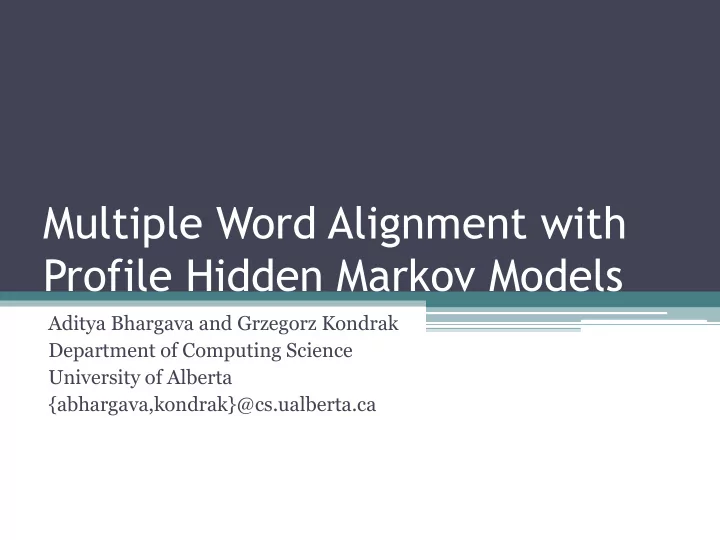

Multiple Word Alignment with Profile Hidden Markov Models Aditya Bhargava and Grzegorz Kondrak Department of Computing Science University of Alberta {abhargava,kondrak}@cs.ualberta.ca
2 Multiple word alignment • Given multiple words, align them all to each other • Our approach: Profile HMMs, used in biological sequence analysis • Use match, insert, and delete states to model changes • Evaluate on cognate set matching ▫ Beat baselines of average and minimum edit distance
3 What you can expect • Introduction: word alignment • Profile hidden Markov models ▫ For bioinformatics ▫ For words? • Experiments • Conclusions & future work
4 Introduction • Multiple word alignment: ▫ Take a set of words ▫ Generate some alignment of these words ▫ Similar and equivalent characters should be aligned together • Pairwise alignment gets us: ▫ String similarity and word distances ▫ Cognate identification ▫ Comparative reconstruction
5 Introduction • Extending to multiple words gets us: ▫ String similarity with multiple words ▫ Better-informed cognate identification ▫ Better-informed comparative reconstruction • We propose Profile HMMs for multiple alignment ▫ Test on cognate set matching
6 Profile hidden Markov models
7 Profile hidden Markov models • Match states are “defaults” • Insert states are used to represent insert symbols • Delete states are used to represent the absence of symbols
8 Profile hidden Markov models MMIIIM AG...C A-AG.C AG.AA- --AAAC AG...C • In this sample DNA alignment, dashes represent deletes and periods represent skipped inserts
9 Profile hidden Markov models MMIIIM AG...C A-AG.C AG.AA- --AAAC AG...C
10 Profile hidden Markov models MMIIIM AG...C A-AG.C AG.AA- --AAAC AG...C
11 Profile hidden Markov models MMIIIM AG...C A-AG.C AG.AA- --AAAC AG...C
12 Profile hidden Markov models MMIIIM AG...C A-AG.C AG.AA- --AAAC AG...C
13 Profile hidden Markov models MMIIIM AG...C A-AG.C AG.AA- --AAAC AG...C
14 Profile hidden Markov models MMIIIM AG...C A-AG.C AG.AA- --AAAC AG...C
15 Profile hidden Markov models MMIIIM AG...C A-AG.C AG.AA- --AAAC AG...C
16 Profile hidden Markov models • To construct a Profile HMM from aligned sequences: ▫ Determine which columns are match columns and which are insert columns, then estimate transition and emission probabilities directly from counts • To construct a Profile HMM from unaligned sequences: ▫ Choose a model length, initialize the model, then train it to the sequences using Baum-Welch
17 Profile hidden Markov models • Evaluating a sequence for membership in a family ▫ Use the forward algorithm to get the probability ▫ Use Viterbi to align the sequence • Multiple alignment of unaligned sequences ▫ Construct & train a Profile HMM ▫ Use Viterbi to align the sequences
18 Profile hidden Markov models • Profile HMMs are generalizations of Pair HMMs ▫ Word similarity and cognate identification • Unlike Pair HMMs, Profile HMMs are position- specific ▫ Each model is constructed from a specific family of sequences ▫ Pair HMMs are trained over many pairs of words
19 Profile HMMs for words • Words are also sequences! • Similar to their use for biological sequences, we apply Profile HMMs to multiple word alignment • We also test Profile HMMs on matching words to cognate sets • We made our own implementation and investigated several parameters
20 Profile HMMs: parameters • Favour match states? • Pseudocount methods ▫ Constant-value, background frequency, substitution matrix • Pseudocount weight • Pseudocounts added during Baum-Welch
21 Experiments: Data • Comparative Indoeuropean Data Corpus ▫ Cognation data for words in 95 languages corresponding to 200 meanings • Each meaning reorganized into disjoint cognate sets
22 Experiments: Multiple cognate alignment • Parameters determined from cognate set matching MIIMIIMI D--E--N- experiments (later) D--E--NY • Pseudocount weight set to 100 to bias the model using a Z--E--N- substitution matrix DZ-E--N- • Highly-conserved columns are aligned correctly DZIE--N- D--A--N- • Similar-sounding characters are aligned also correctly, DI-E--NA thanks to the substitution matrix method D--E--IZ • Insert columns should not be considered aligned D--E---- D--Y--DD • Problems with multi-character phonemes D--I--A- ▫ An expected problem when using the English alphabet D--I--E- instead of e.g. IPA D-----I- Z-----I- Z--U--E- Z-----U- J--O--UR DJ-O--U- J--O--UR G--IORNO
23 Experiments: Cognate set matching • How can we evaluate the alignments in a principled way? There is no gold standard! • We emulate the biological sequence analysis task of matching a sequence to a family; we match a word to a cognate set • The task is to correctly identify the cognate set to which a word belongs given a number of cognate sets having the same meaning as the word; we choose the model yielding the highest score
24 Experiments: Cognate set matching • Development set of 10 meanings (~5% of the data) • Substitution matrix derived from Pair HMM method • Best parameters: ▫ Favour match states ▫ Use substitution matrix pseudocount ▫ Use 0.5 for pseudocount weight ▫ Add pseudocounts during Baum-Welch
25 Experiments: Cognate set matching Accuracy 100% 90% 80% 70% 60% 50% 40% 30% 20% 10% 0% Average Edit Distance Minimum Edit Distance Profile HMM Average Edit Distance: 77.0% Minimum Edit Distance: 91.0% Profile HMM: 93.2%
26 Experiments: Cognate set matching • Accuracy better than both average and minimum edit distance • Why so close to MED? ▫ Many sets had duplicate words (same orthographic representation for different languages)
27 Conclusions • Profile HMMs can work for word-related tasks • Multiple alignments are reasonable • Cognate set matching performance exceeds minimum and average edit distance • If multiple words need to be considered, Profile HMMs present a viable method
28 Future work • Better model construction from aligned sequences • Better initial models for unaligned sequences • Better pseudocount methods • N-gram output symbols
Recommend
More recommend